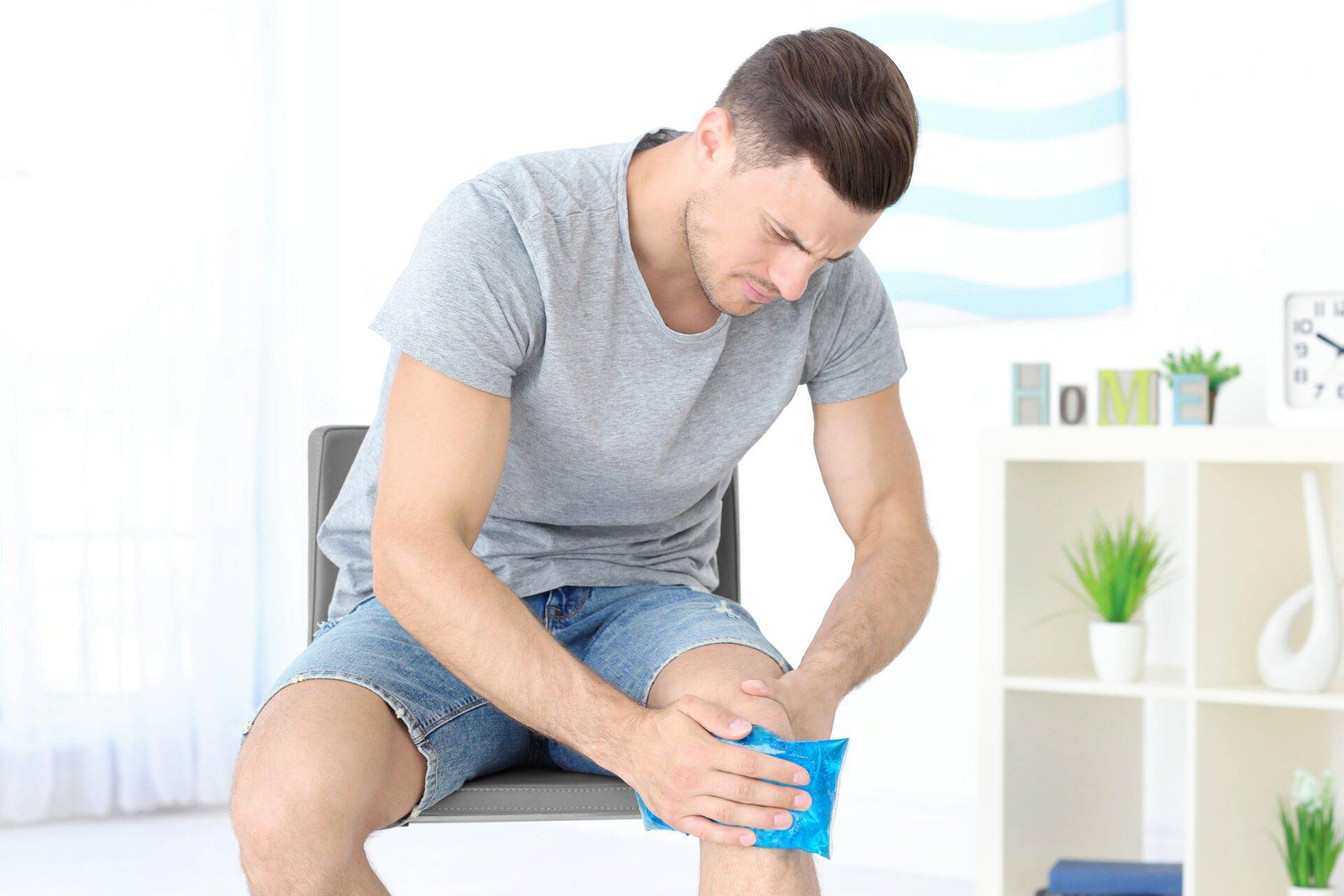By Dr. Richard Thompson, DC
5 Minute Read
Whether to apply ice or heat for pain or injury is probably the most common discussion I have with patients on a daily basis surrounding their at-home management protocols. The decision to apply ice or heat also remains one of the greatest debates within the literature and amongst healthcare professionals. This often leads to differing and inconsistent recommendations to patients, for a number of reasons. Both the limited and contradictory research on the subject as well as healthcare practitioners’ clinical experience and judgement may lead to different recommendations on whether to use ice or heat for pain.

What Does the Research Say?
One of the reasons that a harmonious message does not exist on whether to ice or heat is because the research does not provide a definitive answer. The greatest reason for this, in my opinion, is that conducting high-quality research on both the subjective and objective benefits of these modalities to patients is virtually impossible. High-quality studies involve groups of participants to be ‘blinded’ by which intervention they are receiving in the study. For example, a study could be looking at subjective reports of pain levels from groups of subjects that receive ice, heat, or a placebo, where they are told they are receiving either ice or heat, but aren’t actually receiving either of them. Clearly, that isn’t something that can be performed as the subjects will undoubtedly know which test group they belong to. From an objective standpoint, it is very difficult to measure physiological changes in the body to ice or heat in live subjects. Objective measuring is limited by the practicality of the test, the inability to measure the outcome without causing harm to the subject, or ethical conflicts surrounding the testing. When testing a new medication, one group can be receiving the actual medication and the ‘blinded’ group can be receiving a sugar pill (or placebo). From there, blood tests and other medical measurements can be performed pre- and post-delivery of the medication (or placebo) and a change can be measured. It is likely that until a study can be performed with proper blinding of patients in an ice or heat study, the debate on which modality is the ‘gold standard’ will probably remain unanswered. As a clinician having to provide an answer to this question, I try to explain my clinical rationale to patients to help them understand what choice makes the most sense for their particular situation.

Your Selection Depends on TIME
One of the most important criteria to use when deciding between ice and heat is the length of time you’ve been dealing with your pain. There are three classifications for injury/pain based on the amount of time since the onset of symptoms. Acute injuries began within the past 14 days, and typically began with a specific incident or quickly became symptomatic over a very short period of time. Sub-acute injuries are those that began between 14 days and 3 months ago. Many of these injuries we see in practice are those that didn’t respond early to home care measures, such as ice, heat, or stretching, and need further treatment intervention. It doesn’t mean that ice or heat aren’t valuable and shouldn’t be performed – they will do their part in conjunction with treatment to help healing occur. Finally, chronic injuries are those that have been ongoing for 3+ months. They are either injuries that have been mismanaged, have gone undiagnosed and untreated, or they are complex conditions that may not have a cure.
Is Inflammation/Swelling A Factor?
Inflammation is the body’s natural response to injury and infection. When we consider tissue healing, there are generally three phases to the process. The inflammatory phase is the first stage, where the body is responding to the initial onset of damage to the cells within the tissue. This is a critical stage of healing, particularly if there is any bleeding involved with the injury, as there is with moderate to severe strain/sprains. The longstanding school of thought has been that if we can shorten the length of the inflammatory phase, the quicker we can progress onto the second and third stages of healing – the proliferative and remodelling phases. However, some of the most recent research has swayed traditional thinking away from accelerating the inflammatory phase to allow for the body’s natural inflammatory response to properly manage tissue healing. The original developer of the RICE protocol – Rest, Ice, Compression and Elevation, has recently published new guidelines where ice should only be used within the first 6 hours of acute injury, primarily for pain control. The argument is that the research says that ice helps with pain, but does not significantly shorten the healing time of an injury. This has caused an even greater debate in healthcare in recent years and further research is needed.
What Are Your Goals of Using Ice or Heat?
I often ask this question to patients since understanding your primary goal of applying ice and/or heat can often help you make the appropriate choice. Generally speaking, if your primary goal is to reduce pain, ice is the better option of the two. Ice helps to reduce pain by numbing a specific type of nerve fibre in the body that sends pain signals to the brain. By cooling the injured tissue, those nerves lose the ability to communicate up the neurological pathway telling the brain there is pain. Chronic pain, however, might benefit from alternating ice and heat, as you are also trying to promote blood flow while managing pain. What’s important to understand is that as a rule, ice reduces blood flow by constricting the blood vessels in the tissues, where heat allows those blood vessels to relax, increasing blood flow. Patients with chronic arthritic conditions, for example, might benefit from the combination of both, as you want to help reduce pain, but also promote blood flow to help maintain joint and tissue mobility. Lastly, if your goal is to sooth or relax tense tissue and pain is really not a factor, then heat is your best option. Sometimes it’s hard to differentiate between pain and tension. I often tell patients that if you are experiencing tension but the intensity of your pain is 3 or less on a scale of 1-10, then heat can be applied.

My Rules of Thumb For Ice vs. Heat
Given everything you’ve just read, you’re probably still wondering, what is the right choice to help with my pain? Because it’s such a complex and very individualized decision, I would like to provide you with the rules of thumb that I provide patients when it comes to using ice vs. heat. I have created these recommendations based on what literature exists surrounding cryotherapy (ice), thermotherapy (heat), sports medicine, and human physiology, as well as clinical experience on what seems to work well for patients at specific stages of their injury.
-
- Acute and sub-acute injuries typically respond best to ice, as the primary goal early in the healing is pain management and inflammation control. It’s been widely recommended that the inflammatory phase and need for ice are roughly 72 hours, but one thing to consider is the impact that continued activity has on the inflamed tissue. Not many of us can STOP using an ankle, knee, or hip for a few days when it’s injured, nor is that advised. So is it possible that the inflammatory period might be longer than 72 hours and ice could be beneficial for as long as we continue to be concerned about inflammation control?
- Heat creates vasodilation or a relaxation of blood vessels to increase blood flow. This can be very helpful in increasing blood flow to tight muscles, thus elevating tissue temperature and improving oxygenation, ultimately creating a decrease in tissue tension. That being said, if the tissue is in an inflamed state, increasing blood flow to the tissue may increase the level of inflammatory agents in the tissue. As discussed, if we are increasing or prolonging the inflammatory phase of healing, this could in turn prolong the overall healing (and symptomatic) time. My simple recommendation is that heat can be appropriate once inflammation and pain levels have been minimized or if your goal is to primarily relax tight tissues that are not painful.
- Chronic injuries are likely to benefit from an alternating cycle of ice and heat or sometimes cycles of heat applied in intervals. Ice and/or heat should be applied in intervals of 10-15 minutes, depending on the depth/size of the body part. Always protect the skin from the ice with a thin piece of paper towel or clothing, and I recommend using a gel-based, pliable ice pack that conforms to the shape of your body part. Moist heat is often the better option in the form of a warm bath or moist heating pack.
- When in doubt, I recommend patients err on the side of icing. As discussed, ice can help with pain and inflammation, and as long as the skin is protected and the ice is applied in appropriate time intervals, the relative risk of negative consequences is rather low. On the other hand, if you apply heat that does increase the level of inflammation, that could have unintended consequences on pain, mobility, and speed of injury recovery.

I am fully aware that this subject matter might raise some eyebrows and some readers might disagree with my commentary. Some patients react negatively to ice for a number of possible reasons, in which case I recommend either avoiding ice or trying heat, as long as I don’t feel it’s a potential risk for their recovery. Some patients respond well to heat for their pain at a time when I would typically recommend using ice. In the end, my greatest recommendation for patients is to always do what your body tells you works best. Ultimately, the decision to use ice and/or heat to augment your healing is optimally made by being informed, and I hope that this article has helped you with just that. If you are using ice and/or heat to manage pain and there is no improvement, I recommend that you reach out to a qualified healthcare professional who can diagnose and provide you with the appropriate guidance on how to best manage the problem. During this time of stay-at-home orders – stay active, stay healthy, and stay informed.

